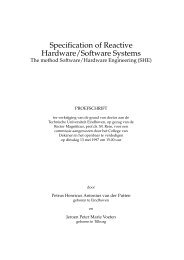MoBAN: A Configurable Mobility Model for Wireless Body Area ...
MoBAN: A Configurable Mobility Model for Wireless Body Area ...
MoBAN: A Configurable Mobility Model for Wireless Body Area ...
Create successful ePaper yourself
Turn your PDF publications into a flip-book with our unique Google optimized e-Paper software.
(a) Average age of data items at the gateway and average transmit power of a node in simulation using <strong>MoBAN</strong><br />
(b) Average age and Tx power level of a node in a real experiment<br />
Figure 4: Simulation results <strong>for</strong> an intra-WBAN communication protocol obtained using <strong>MoBAN</strong> and results<br />
of a real experiment.<br />
4.2 Recording and Reusing <strong>Mobility</strong> Patterns<br />
The mobility pattern influences the per<strong>for</strong>mance evaluation<br />
results of a network protocol when there is some <strong>for</strong>m<br />
of mobility in the network. This effect is more important in<br />
simulating networks including WBANs because of the high<br />
mobility in these networks. On the other hand, sometimes<br />
we simulate a protocol to compare its per<strong>for</strong>mance with alternative<br />
protocols. In such a situation, to have fairer comparison,<br />
it is worthwhile to use the exact same mobility pattern<br />
<strong>for</strong> simulating different protocols.<br />
In our implementation of the WBAN mobility model, we<br />
have the feature of logging the mobility pattern of a WBAN.<br />
The coordinator module logs the selected destinations, velocity<br />
values and posture pattern in a file if the logging function<br />
is requested. The coordinator module can be set to read<br />
a previously logged mobility pattern of an earlier simulation<br />
run by specifying the name of the input mobility pattern<br />
file. To simulate different protocols <strong>for</strong> a given network, we<br />
may run the first simulation and log the mobility pattern.<br />
Then, <strong>for</strong> the rest, we use the logged pattern.<br />
5. CASE STUDIES<br />
We used <strong>MoBAN</strong> with special configurations to evaluate<br />
communication protocols that we have presented in our earlier<br />
publications [17] and [18]. In this section, the impact<br />
of the mobility model on simulations is investigated. Moreover,<br />
as these two case studies concern different protocols<br />
(one <strong>for</strong> intra- and another one <strong>for</strong> extra-WBAN communication),<br />
the applicability and configurability of the model<br />
<strong>for</strong> different applications are illustrated.<br />
5.1 Intra-WBAN Protocol Stack<br />
In [17], we proposed a multi-hop protocol stack <strong>for</strong> intra-<br />
WBAN communication aiming to provide robustness against<br />
network topology changes due to the posture changes and<br />
low link quality in WBANs. All sensor nodes need to send<br />
their data items to a gateway node on the body. Because of<br />
a very short transmission range of wireless devices deployed<br />
on the body, nodes may not be able to reach the gateway<br />
in one hop. The protocol suggests a gossip-based [8] routing<br />
mechanism together with an appropriate TDMA-based<br />
Medium Access Control (MAC) to reliably deliver in<strong>for</strong>mation<br />
to the gateway node through one or more hops. As<br />
the protocol does not rely on any specific routing structure<br />
like a tree, there is no need <strong>for</strong> reconstructing the routing<br />
structure upon network topology changes (due to the posture<br />
changes and node mobility). This makes the protocol<br />
robust against those changes in the network topology.<br />
Moreover, a transmit power adaptation mechanism is proposed<br />
to optimize the transmit power consumption of sensor<br />
nodes while realizing the proper node connectivity to meet<br />
the quality-of-service requirements.<br />
To evaluate the per<strong>for</strong>mance and robustness of such a protocol,<br />
a WBAN mobility model including different postures<br />
is the first prerequisite as the protocol aims to provide robustness<br />
with respect to such topology changes. We used<br />
a particular configuration of <strong>MoBAN</strong> to this aim. Twelve<br />
sensor nodes including the gateway node are supposed to be<br />
installed on different positions in the WBAN. Accordingly,<br />
the specifications of five different postures are defined and<br />
the initial Markov model of Fig. 2(a) is used to generate the

















